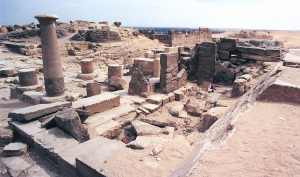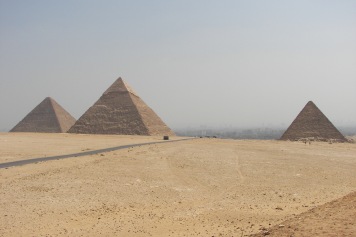I’m out with my thiasos this weekend, so am posting this a bit early. I hadn’t known that there was an Isis temple at Giza. But, yep, there is.
There is a most interesting inscription on an artifact known as the Inventory Stela from the Giza Plateau.
It has caused a lot of excitement, especially among those who believe that the Sphinx and Pyramids are older than the fourth dynasty period to which Egyptologists usually attribute their construction.
You’ll immediately see why I was interested. Here’s what it says according to the great Egyptologist Gaston Maspero’s translation of the stele:
Live Horus the Mezer, the King of Upper and Lower Egypt, Khufu, given life. He made for his mother Isis, the Divine Mother, Mistress of the Western Mountain [that is, the necropolis], a decree made on a stela, he gave to Her a divine offering, and he built Her a temple of stone, renewing what he had found, namely the Gods in Her place.
Live Horus, the Mezer, the King of Upper and Lower Egypt, Khufu, given life. He found the House of Isis, Mistress of the Pyramid, by the side of the cavity of the Sphinx, on the northwest side of the House of Osiris, Lord of Rostaw, and he built his pyramid beside the temple of this Goddess, and he built a pyramid for the King’s Daughter, Henut-sen, beside this temple. The place of Hwran-Hor-em-akhet [that is, the Sphinx] is on the south of the House of Isis, Mistress of the Pyramid, and on the north of Osiris, Lord of Rostaw. The plans of the Image of Hor-em-akhet were brought in order to bring to revision the sayings of the disposition of the Image of the Very Redoubtable. He restored the statue all covered in painting, of the Guardian of the Atmosphere, who guides the winds with his gaze.
He made to quarry the hind part of the nemes headdress, which was lacking, from gilded stone, and which had a length of about 7 ells [3.7 metres]. He came to make a tour, in order to see the thunderbolt, which stands in the Place of the Sycamore, so named because of a great sycamore, whose branches were struck when the Lord of Heaven descended upon the place of Hor-em-akhet, and also this image, retracing the erasure according to the above-mentioned disposition, which is written {…} of all the animals killed at Rostaw. It is a table for the vases full of these animals which, except for the thighs, were eaten nears these seven gods, demanding {…} (The God gave) the thought in his heart, of putting a written decree on the side of this Sphinx, in an hour of the night. [That is, the pharaoh had a dream from the Sphinx that he should do this.] The figure of this God, being cut in stone, is solid, and will exist to eternity, having always its face regarding the Orient.
The rest of the stele is taken up with a list of the sacred images of the Deities that Khufu restored within the Temple of Isis. The largest part of the stele is an inventory of these images, which is why it is known as “the Inventory Stele.”
Pretty cool, huh?
What excites me, of course, is the Temple of Isis reference and the title “Mistress of the Pyramid.” What excites most of those who get excited is that the stele—supposed to have been carved by Khufu’s fourth-dynasty sculptors on the king’s orders—says that the Sphinx was already there! What’s more, apparently the little Temple of Isis was there even before Khufu built his Great Pyramid.
Alas, most Egyptologists agree that the stele is an archaized work, probably created sometime between the 25th and 26th dynasties, during a period when Nubian kings were trying to revitalize Egypt by harking back to its Old Kingdom glory days. The style of art and writing point most clearly to the 26th dynasty. Key to the evidence is that we have no reference to “Hwran” and “Hor-em-akhet” as names for the Sphinx until the 18th dynasty.
As for the Temple of Isis, it was originally a funerary chapel associated with the pyramid of Henutsen, Khufu’s half sister or, as the Inventory Stele says, “king’s daughter.” It was “found” by the pharaoh Pasebekhanu in the 21st dynasty and either converted into a small Temple of Isis at that time or, because the pharaoh either had or believed he had found the remains of an earlier Isis temple, had it refurbished as one. There Isis was worshipped as Lady of the Pyramid (or perhaps, Pyramids) until the Roman period. We even have evidence that Her cult had its own priesthood.
Prior to the Inventory Stele, we find Isis on a Giza stele of Prince Amenomopet, a prince of the 18th dynasty. She is found on the so-called Stele C found in the Sphinx Temple and which shows the Sphinx and Isis, wearing the Horns and Disk Crown and within a shrine, receiving offerings from the prince. The image is captioned, “Isis, the Great, the Divine Mother, Queen of the Gods, One in Heaven, Who Has No Equal, the Elder [daughter of] Atum.” Dating on the stele is controversial (so what else is new in Egyptology?), but if the 18th dynasty is accurate, then Isis and the Sphinx are being worshipped together at Giza by at least that time.
After this period, we have a number of other Giza inscriptions that include Isis. Some that list Her with other Deities, notably Osiris and Horus, some that indicate that She was being worshipped alone. So it would seem that there was an active cult of Isis at Giza from at least the 18th dynasty. There is also evidence of private devotion at the Temple of Isis; a number of votive plaques have been found there as well. (By the way, all of this has been gathered together by Christiane M. Zivie-Coche in her book Giza Au Premier Millenaire Autour du Temple D’Isis, Dames des Pyramides; I’m struggling through the French, so bear with me.)
We also have several fragments of columns, probably from the Ramessid era, but which were reused in the Third Intermediate Period by Pharaoh Amenemope, on which the king offers wine to Osiris and Isis, Who is identified specifically as Lady of the Pyramids. Because the column was reused, we can’t be sure whether that epithet goes back to the Ramessid period or only began being used in the 21st dynasty. But from then on, one of the Goddess’ epithets is Mistress or Lady of the Pyramids, which likely refers to Her function of protecting the pyramids and the Osiris-kings in them, and surely to Her power to safeguard their rebirths as well.

Interestingly, a graffito on Henutsen’s pyramid from (probably) Egypt’s late period says that the pyramid is the burial place of Isis. Oriented to the south, it faced the symbolic burial place of Osiris, Lord of Rostaw.
Much later, in the mid 1500s, writer André Thévet (Cosmographie de Levant, 1556) continued the tradition of Isis with the Sphinx writing that the Sphinx has “the head of a colossus, caused to be made by Isis, daughter of Inachus, then so beloved of Jupiter”. (This refers to the Isis-Io connection; Io is the daughter of Inachus, the River God. Zeus fell in love with Io. You can read the whole story here.)
I’ve never been much interested in pyramids or mummies or pharoahs. It was always the Deities for me. Guess that’s why I missed this epithet of Isis previously. Just goes to show, there’s always something new to learn about Her.







